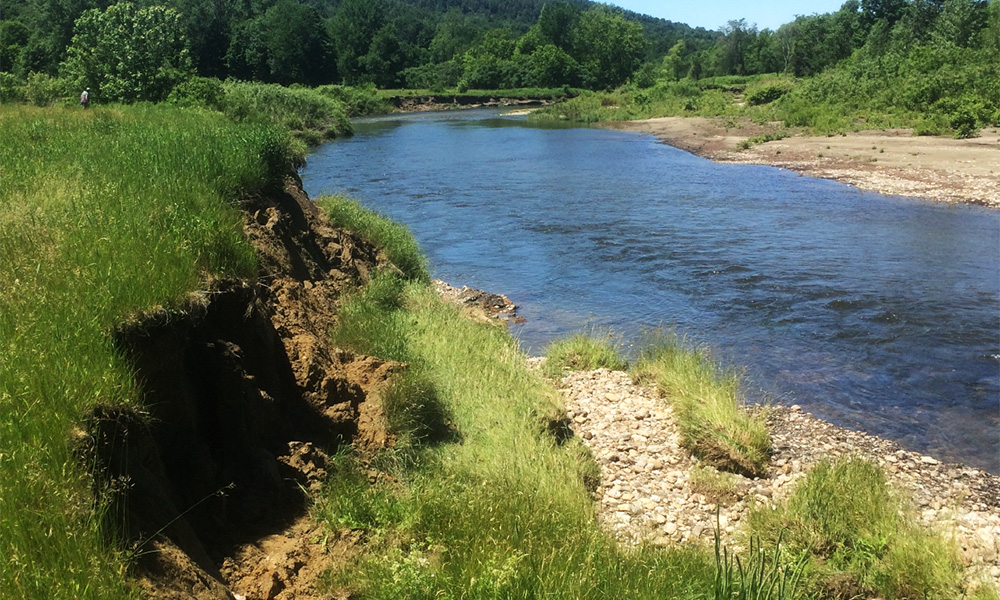Comparing Soil and Stream Phosphorus Among Farms, Wetlands and Forests in Vermont
Apr. 8th 2021All the land in a watershed drains, by way of streams and rivers, to one major water body, such as Lake Champlain in Vermont. Watershed land use affects the nutrients and sediments that run off into streams. Excess nutrients, such as phosphorus, are known to contribute to eutrophication in downstream water bodies. Eutrophication is the dense growth of algae and plants that can cause lack of oxygen and die off of aquatic animals.
Agricultural land uses can be significant sources of phosphorus runoff into waterways. In locations with animal agriculture, such as the dairy industry in Vermont, phosphorus in feed and fertilizer can result in a buildup of soil phosphorus, especially in fields receiving repeated additions of manure.
This history of phosphorus addition—up to 2- to 10-times greater than naturally found in forests—results in the accumulation of “legacy” soil phosphorus, which has the potential to be a future source of phosphorus export to streams. In contrast, forests and many wetlands do not usually have land use-caused inputs of phosphorus.
Streambank erosion can add to phosphorus moving into streams, especially when there is agricultural land use immediately adjacent to streambanks. When streambank soils erode into a stream, the fresh sediment can be a sink or a source of phosphorus.
“If the soils have accumulated legacy phosphorus and have a high degree of phosphorus saturation, they will likely release phosphorus to the stream,” said Donald Ross, a former soil scientist at the University of Vermont. “If soil is low in both legacy phosphorus and phosphorus saturation, such as found in forests, the eroded streambanks could act as a sink and remove phosphorus from the stream.”
Understanding the relationship of soil phosphorus concentrations among land uses within a watershed and their corresponding streambanks may improve insight into current and future controls of phosphorus export, a topic of concern in Vermont.
In Lake Champlain, an international water body which borders Vermont, New York, and Quebec, phosphorus concentrations have increased since monitoring started in 1990. Ross, graduate student Vanesa Perillo, and co-researchers at the University of Vermont conducted a recent study on the effect of land use management on soil phosphorus within Vermont and Quebec’s Missisquoi River watershed, which flows into Lake Champlain.
They investigated phosphorus in soils on 32 sites along streams in the watershed. From May to August, they studied four different land uses—cornfield, hayfield, wetland, and forest—and their adjacent streambanks. All eight cornfields and six of the eight hayfields received annual manure applications.
The researchers collected soil samples and analyzed the soil in the laboratory. They found that soil phosphorus concentrations varied widely among the four watershed land uses.
Both forest streambank and forest interior soils were relatively low in total phosphorus, while soils in cornfields, hayfields, and wetlands contained elevated levels of phosphorus (>1000 mg/kg). Although, the total phosphorus of the corresponding streambanks of these three land uses was significantly lower than in the interior of the land use, sites with higher total phosphorus in the interior had high levels of total phosphorus in their streambank soils.
This suggests a possible influence of land use (corn, hay, or wetland) on its adjacent streambank. The wetland with the greatest soil phosphorus had a history of agricultural land use, and its high total phosphorus could be from sources of legacy phosphorus remaining from past farming practices.
Most of the streambank soils from the four different land uses had low levels of a type of phosphorus called “bioavailable” which means the total phosphorus has a low release potential and is less likely to contribute to phosphorus enrichment downstream. However, the elevated total phosphorus in some agricultural streambank soils suggests an accumulation of legacy phosphorus that could be released into streams in the future.
The large streambank erosion rates and sediment loads being transported into rivers and their tributaries in the Lake Champlain basin suggest that sediment-bound phosphorus will continue to be a significant concern. The interior of cornfields and hayfields high in total phosphorus, if eroded by extreme weather events, such as happened with Tropical Storm Irene in the northeastern United States in 2011, could act as sources of phosphorus to Lake Champlain.
The researchers suggest that land use practices such as exclusionary fencing for cattle and vegetated buffer zones are important to reduce streambank erosion. However, these riparian strategies will need to be combined with methods to lessen agricultural sources of phosphorus through “phytomining”—extraction of phosphorus by biomass production—tillage, and phosphorus absorbing amendments.
 ecoNEWS VT
ecoNEWS VT